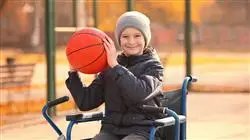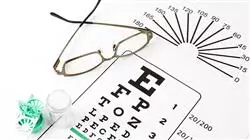University certificate
The world's largest faculty of education”
Introduction to the Program
This program is a complete update of knowledge, what are you waiting for to enroll and become your best professional version?”

Addressing special disorders in education is an imminent need, which is why teachers play an important role in the management of musculoskeletal diseases, eye and hearing problems. To this extent, the role of the educator is of utmost importance for the development of physical skills and the management of appropriate behavior in different social situations.
Thus, it is essential to update knowledge in terms of educational techniques and methodologies, since the teachers have to identify students with motor problems and use education to overcome their difficulties and problems. Thus, by combining education and the different types of therapies for the management of skills, they will be able to maximize the physical abilities of their students.
Finally, this Postgraduate diploma will address specific aspects of the diseases that affect the locomotor system and that in turn have an impact on the senses of vision and hearing. This will help the professionals to perform a better praxis, so that their deployment in the classroom will demonstrate a broad knowledge and more than effective management of students with motor problems or difficulties. However, they will also acquire basic knowledge about therapies in the case of a medical emergency.
Therefore, this program is presented as an opportunity for the professionals in the educational sector. With an innovative 100% online format, it will have the best academic features, specialist teachers in the field, highly efficient materials and the necessary content for today's industry.
Stand out and be part of the best educators of the future, who contribute to the education of thousands of children, youth and adults”
This Postgraduate diploma in Motor Disorders, Eye and Hearing Problems contains the most complete and up-to-date Educational program on the market. Its most outstanding features are:
- Practical cases presented by experts in Motor Disorders, Eye and Hearing Problems
- The graphic, schematic and eminently practical contents of the book provide information and practice on those disciplines that are essential for professional practice
- Practical exercises where the self-assessment process can be carried out to improve learning
- Its special emphasis on innovative methodologies
- Theoretical lessons, questions to the expert, debate forums on controversial topics, and individual reflection assignments
- Content that is accessible from any fixed or portable device with an Internet connection
Update your skills in neurological bases of development and learning and become an expert with the use of the most advanced educational tools”
The program’s teaching staff includes professionals from the sector who contribute their work experience to this training program, as well as renowned specialists from leading societies and prestigious universities.
Its multimedia content, developed with the latest educational technology, will provide the professionals with situated and contextual learning, i.e., a simulated environment that will provide an immersive education programmed to learn in real situations.
This program is designed around Problem-Based Learning, whereby students must try to solve the different professional practice situations that arise throughout the program. For this purpose, students will be assisted by an innovative, interactive video system created by renowned and experienced experts.
Contributes to the special education of children with Motor Disorders and Eye and Hearing Problems"

Take your knowledge to the maximum and learn about the management of diseases of the locomotor system to solve emergencies in the classroom"
Why study at TECH?
TECH is the world’s largest online university. With an impressive catalog of more than 14,000 university programs available in 11 languages, it is positioned as a leader in employability, with a 99% job placement rate. In addition, it relies on an enormous faculty of more than 6,000 professors of the highest international renown.

Study at the world's largest online university and guarantee your professional success. The future starts at TECH”
The world’s best online university according to FORBES
The prestigious Forbes magazine, specialized in business and finance, has highlighted TECH as “the world's best online university” This is what they have recently stated in an article in their digital edition in which they echo the success story of this institution, “thanks to the academic offer it provides, the selection of its teaching staff, and an innovative learning method aimed at educating the professionals of the future”
A revolutionary study method, a cutting-edge faculty and a practical focus: the key to TECH's success.
The most complete study plans on the university scene
TECH offers the most complete study plans on the university scene, with syllabuses that cover fundamental concepts and, at the same time, the main scientific advances in their specific scientific areas. In addition, these programs are continuously being updated to guarantee students the academic vanguard and the most in-demand professional skills. In this way, the university's qualifications provide its graduates with a significant advantage to propel their careers to success.
TECH offers the most comprehensive and intensive study plans on the current university scene.
A world-class teaching staff
TECH's teaching staff is made up of more than 6,000 professors with the highest international recognition. Professors, researchers and top executives of multinational companies, including Isaiah Covington, performance coach of the Boston Celtics; Magda Romanska, principal investigator at Harvard MetaLAB; Ignacio Wistumba, chairman of the department of translational molecular pathology at MD Anderson Cancer Center; and D.W. Pine, creative director of TIME magazine, among others.
Internationally renowned experts, specialized in different branches of Health, Technology, Communication and Business, form part of the TECH faculty.
A unique learning method
TECH is the first university to use Relearning in all its programs. It is the best online learning methodology, accredited with international teaching quality certifications, provided by prestigious educational agencies. In addition, this disruptive educational model is complemented with the “Case Method”, thereby setting up a unique online teaching strategy. Innovative teaching resources are also implemented, including detailed videos, infographics and interactive summaries.
TECH combines Relearning and the Case Method in all its university programs to guarantee excellent theoretical and practical learning, studying whenever and wherever you want.
The world's largest online university
TECH is the world’s largest online university. We are the largest educational institution, with the best and widest online educational catalog, one hundred percent online and covering the vast majority of areas of knowledge. We offer a large selection of our own degrees and accredited online undergraduate and postgraduate degrees. In total, more than 14,000 university degrees, in eleven different languages, make us the largest educational largest in the world.
TECH has the world's most extensive catalog of academic and official programs, available in more than 11 languages.
Google Premier Partner
The American technology giant has awarded TECH the Google Google Premier Partner badge. This award, which is only available to 3% of the world's companies, highlights the efficient, flexible and tailored experience that this university provides to students. The recognition as a Google Premier Partner not only accredits the maximum rigor, performance and investment in TECH's digital infrastructures, but also places this university as one of the world's leading technology companies.
Google has positioned TECH in the top 3% of the world's most important technology companies by awarding it its Google Premier Partner badge.
The official online university of the NBA
TECH is the official online university of the NBA. Thanks to our agreement with the biggest league in basketball, we offer our students exclusive university programs, as well as a wide variety of educational resources focused on the business of the league and other areas of the sports industry. Each program is made up of a uniquely designed syllabus and features exceptional guest hosts: professionals with a distinguished sports background who will offer their expertise on the most relevant topics.
TECH has been selected by the NBA, the world's top basketball league, as its official online university.
The top-rated university by its students
Students have positioned TECH as the world's top-rated university on the main review websites, with a highest rating of 4.9 out of 5, obtained from more than 1,000 reviews. These results consolidate TECH as the benchmark university institution at an international level, reflecting the excellence and positive impact of its educational model.” reflecting the excellence and positive impact of its educational model.”
TECH is the world’s top-rated university by its students.
Leaders in employability
TECH has managed to become the leading university in employability. 99% of its students obtain jobs in the academic field they have studied, within one year of completing any of the university's programs. A similar number achieve immediate career enhancement. All this thanks to a study methodology that bases its effectiveness on the acquisition of practical skills, which are absolutely necessary for professional development.
99% of TECH graduates find a job within a year of completing their studies.
Postgraduate Certificate in Motor Disorders, Eye and Hearing Problems
Today, the care and support of individuals with motor disorders, eye and hearing impairments requires highly trained professionals. If you are interested in specializing in this field and making a significant difference in the lives of those facing these conditions, TECH Global University's Postgraduate Diploma in Motor, Eye and Hearing Disorders program is the ideal choice for you. Our online class program gives you the flexibility to study from anywhere and at any time, adapting to your schedule and needs. Through our interactive online classes, you will have access to quality didactic material, taught by experts in the field of health and rehabilitation. In addition, you will have the opportunity to interact with other professionals and share experiences, enriching your learning.
Expand your knowledge and make a difference in the care of people with disabilities
.
In the Postgraduate Diploma in Motor Disorders, Ocular and Hearing Problems, you will acquire up-to-date knowledge on the latest assessment, diagnosis and treatment techniques in these fields. You will learn to develop effective and person-centered intervention strategies, comprehensively addressing the motor, visual and hearing difficulties that your patients may present. TECH Global University offers you the opportunity to access quality training, supported by our highly qualified faculty who are committed to your professional success. In addition, you will be able to apply your knowledge in real situations through internships and case studies, strengthening your practical skills and your confidence in the field. Don't miss the opportunity to become a professional specializing in motor disorders, eye and hearing problems! Expand your knowledge and skills in the field of health and rehabilitation.Enroll in the Postgraduate Diploma in Motor Disorders, Eye and Hearing Problems at TECH Global University and make a difference in the lives of people in need!







